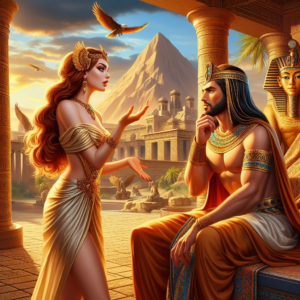Abraham, Joseph an Moses in Egypt
 The interesting narrative of Abraham, Joseph, and Moses in Egypt, with insights from Princeton Theological Seminary lectures and Siptah’s tomb. Discover the secrets of Egypt’s past by exploring the roles played by these biblical people in Egyptian history with Rev. Alfred H. Kellogg, D.D.
The interesting narrative of Abraham, Joseph, and Moses in Egypt, with insights from Princeton Theological Seminary lectures and Siptah’s tomb. Discover the secrets of Egypt’s past by exploring the roles played by these biblical people in Egyptian history with Rev. Alfred H. Kellogg, D.D.
Rev. Alfred H. Kellogg, D.D.’s book “Abraham, Moses, Joseph in Egypt” explores the interwoven histories of these biblical characters in the setting of ancient Egypt. The author presents an engaging story that clarifies the roles and significance of Abraham, Moses, and Joseph in Egyptian history through a careful examination of historical sources, including inscriptions from Siptah’s tomb and lectures given at the Theological Seminary in Princeton.
The Hebrew chronology and its interpretation in the Old and New Testaments are covered in the first section of the book. The exactness and symbolic value of the 430-year span that culminated on the day of the Exodus are highlighted by Kellogg, who also stresses the relevance of this timeframe in biblical accounts. The author deftly handles the challenges of dating the era of Israel’s fall into Egypt and the events that followed including Abraham, Joseph, and Moses by examining passages from Genesis and Exodus.
Kellogg’s research encompasses a comparative chronology of biblical stories and Egyptian monuments. He takes a cautious and intellectual approach to the topic, pointing out that some of the findings are speculative while arguing in favour of a balanced interpretation of the historical facts found in both sources. The author argues against the inclination to overly extend Egypt’s chronology and in favour of a more accurate and sophisticated method of historical study.
With an acute attention to detail, Kellogg makes connections between historical events, nature, and living throughout the book, demonstrating their origins and consequences. Through the analysis of philological and linguistic facets of historical writings, the writer unearths nuanced hints that allude to momentous occasions like Egyptian exodus and their effects on the nation’s political and social climate.
The story comes to a close with a thorough analysis of the stories of Abraham, Joseph, and Moses in Egypt, providing a thorough picture of their respective roles and the historical settings in which they were active. A plethora of data from other sources bolsters Kellogg’s research, offering a rich tapestry of insights into the interwoven histories of these biblical people and ancient Egypt.
To sum up, “Abraham, Moses, Joseph in Egypt” is an insightful and painstakingly studied examination of the historical points where biblical stories and Egyptian history converge. This book is an invaluable resource for anybody interested in solving historical puzzles and comprehending the lasting relevance of these well-known biblical characters in the annals of history because of Kellogg’s meticulous attention to detail and academic approach.